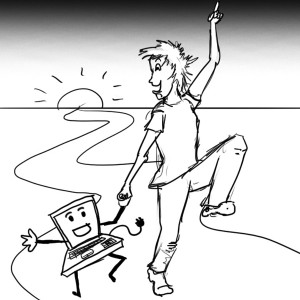Laptop-free classrooms need to go
When was the last time you used a laptop?
Whether students type an essay in Microsoft Word, scroll through an article in PDF form or compile notes in Google Docs, technology serves as an integral part of our day-to-day college lives.
Naturally, when professors issue a “no laptops allowed” classroom policy, many students become discouraged.
We understand why they do it, as laptops are often considered a distraction. But as technology develops, it becomes increasingly intertwined with education. Instructors who don’t allow laptops in the classroom are behind the times.
Many professors argue that laptops are distracting. But let’s consider why students become tempted to hop on Facebook or to chat with friends in the first place — in many cases, they simply aren’t engaged in class.
Two-hour-long oral lectures and 50-slide PowerPoint decks full of black-and-white text do not keep students’ attention.
In many fields, the online sphere defines the future of the industry. Banning technology in the classroom sends conflicting messages about that development.
Banning technology assumes that the only solution to students’ short attention spans is the removal of distractions.
Students will inevitably face those same distractions as professionals once they enter the workforce. Rather than accusing laptops of being distracting, professors should use technology to their advantage to make classes more engaging.
A recent study by the Southern Cross University in Australia found that Twitter helps shy students share their ideas in the classroom and encourages class participation.
In the study, students anonymously tweeted their comments on class material and those comments showed up on their professors’ laptops via PowerPoint. In this manner, professors used laptops to engage students rather than distract them.
At a recent conference for journalism educators, Robert Hernandez, an assistant professor of professional practice, monitored a live Twitter feed, illustrating its ability to enrich conversation and encourage idea generation.
Twitter is a great example, but it’s only a starting point. Professors can brainstorm other ways to engage students through the use of online collaboration and technology tools.
Though USC does not have an official policy on laptops in the classroom, President C. L. Max Nikias recently mentioned in KPCC Radio’s “What is the Future of Higher Education?” roundtable discussion that USC has prioritized the integration of new technology into the classroom environment.
As part of this strategy, the university has added courses that weave interactive components into the usual lectures.
The responsibility of avoiding distractions on laptops, however, lies solely in students’ hands. Though it’s not a crime to discretely send a time-sensitive email in class, it’s another thing to spend an entire lecture scrolling through Facebook. Even if we opt to use our laptops, professors deserve our attention and respect.
Technology in the classroom is ultimately a two-way street. Professors must adopt it in a way that engages students and teaches them the material, and students should actively participate and not abuse laptop privileges in class.
Whether professors decide to allow laptops or not, they cannot deny that laptops are an increasingly essential part of student life.
If professors look to technology as a potential medium for improving the classroom experience rather than hampering it, both parties will benefit.
Jasmine Ako is a senior majoring in business administration.


Totally agree with Jon. The millenial generation is pathetic – you can’t lend your time to someone else to try and learn something during an hour and a half session? What’s the matter, those “rigorous” BUAD classes not exciting enough for you?
This is idiotic. It isn’t up to professors to ENTERTAIN you. You need to make an effort to learn. Going on facebook before the prof even opens his mouth is not making an effort. And it happens ALL THE TIME. And, unlike the doodling of older generations of students, surfing the web during class is distracting to other students.